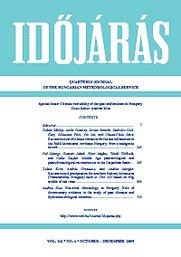Időjárás - Quarterly Journal of the Hungarian Meteorological Service (OMSZ)
Vol. 113, No. 4 * Pages 245–339 * October - December 2009
 |
Guest Editor: Andrea Kiss |
Reconstruction of climate variation for the last millennium in the Bükk Mountains, northeast Hungary, from a stalagmite record
Siklósy Zoltán, Demény Attila, Szenthe István, Leél-Õssy Szabolcs, Pilet, S., Lin, Y., Shen, C.C.
idojaras.2009.4.1 (p. 245–)
Siklósy Zoltán, Demény Attila, Szenthe István, Leél-Õssy Szabolcs, Pilet, S., Lin, Y., Shen, C.C.
idojaras.2009.4.1 (p. 245–)
Middle Age paleoecological and paleoclimatological reconstruction in the Carpathian Basin
Sümegi Pál, Jakab Gusztáv, Majkut Péter, Törõcsik Tünde, Zatykó Csilla
idojaras.2009.4.2 (p. 265–)
Sümegi Pál, Jakab Gusztáv, Majkut Péter, Törõcsik Tünde, Zatykó Csilla
idojaras.2009.4.2 (p. 265–)
Reconstructed precipitation for southern Bakony Mountains (Transdanubia, Hungary) back to 1746 AD based on ring widths of oak trees
Kern Zoltán, Grynaeus András, Morgós András
idojaras.2009.4.3 (p. 299–)
Kern Zoltán, Grynaeus András, Morgós András
idojaras.2009.4.3 (p. 299–)
Historical climatology in Hungary: Role of documentary evidence in the study of past climates and hydrometeorological extremes
Kiss Andrea
idojaras.2009.4.4 (p. 315–)
Kiss Andrea
idojaras.2009.4.4 (p. 315–)
IDŐJÁRÁS - Quarterly Journal

Az IDŐJÁRÁS a HungaroMet Nonprofit Zrt. negyedévenként megjelenő angol nyelvű folyóirata
Megrendelhető a journal.idojaras@met.hu címen.
A szerzőknek szánt útmutató itt olvasható.
Megrendelhető a journal.idojaras@met.hu címen.
A szerzőknek szánt útmutató itt olvasható.









